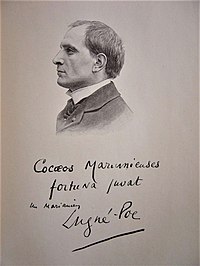Lugné-Poe
Aurélien-Marie Lugné[1] (27 December 1869 – 19 June 1940), known by his stage-name and pen name Lugné-Poe,[2] was a French actor, theatre director, and scenic designer best known for his work at the Théâtre de l'Œuvre,[3] one of the first theatrical venues in France to provide a home for the artists of the symbolist movement at the end of the nineteenth century.[4] Most notably, Lugné-Poe introduced French audiences to the Scandinavian playwrights August Strindberg and Henrik Ibsen.[5]
Lugné-Poe | |
|---|---|
 Lugné-Poe in Figures contemporaines tirées de l’Album Mariani. Etching c. 1903. | |
| Born | 27 December 1869 Paris, France |
| Died | 19 June 1940 (aged 70) |
| Education | Paris Conservatoire (1889–1891) |
| Known for | Theatre Director, Designer |
| Movement | Symbolism |
| Spouse(s) | Suzanne Desprès |
| Awards | Officier, Lègion d'Honneur |
Life and career
At age nineteen he entered the Paris Conservatoire and joined the Théâtre Libre, a private naturalist theatre run by André Antoine. He adopted the stage name Lugné-Poe in homage to Edgar Allan Poe,[3] to whom he sometimes claimed to be distantly related.[6]
He organized a group of painters known as The Nabis, publicizing their work in a series of articles.[6]
He created La Maison de l'Œuvre, also known as Le Théâtre de l'Œuvre, a private group of spectators and experimental theatre that went against the naturalist movement and contributed to the symbolist movement in theatre and to the discovery of new playwrights.
In 1895, Jakub Grein and the Independent Theatre Society invited Lugné-Poe and his troupe to present a season of Ibsen's Rosmersholm, The Master Builder, and Maurice Maeterlinck's symbolist L'Intruse and Pelléas and Mélisande in London.[7]
Works
- 1893: Pelléas et Mélisande (Maurice Maeterlinck)
- 1898: La Victoire (Bouhélier)
- 1898: Solness le constructeur (Henrik Ibsen, translated by Prozor)
- 1899: Entretien d'un philosophie avec la maréchale de XXX (Diderot)
- 1899: Le Triomphe de la raison (Rolland)
- 1893: Rosmersholm (Henrik Ibsen, translated by Prozor)
- 1893: Un Ennemi du peuple (Henrik Ibsen, translated by Chennevière and Johansen)
- 1893: Ames solitaires (Gerhart Hauptmann, translated by Cohen)
- 1894: L'Araignée de cristal (Rachilde)
- 1894: Au-dessus des forces humaines (Björnstjerne-Björnson, translated by Prozor)
- 1894: Une Nuit d'avril à Céos (Trarieux)
- 1894: L'Image (Beaubourg)
- 1894: Solness le construsteur (Henrik Ibsen, translated by Prozor)
- Nouveau-Théâtre
|
|
|
- Comédie-Parisienne
|
|
|
- Théâtre du Ménus-Plaisirs
- 1895: L'École de l'idéal (Vérola)
- 1895: Le Petit Eyolf (Henrik Ibsen, translated by Prozor)
- 1895: Le Volant (Paul Claudel)
- Salle de Trianon, Paris
- 1906: Madame la marquise (Sutro)
- 1906: Le Troisième Couvert (Savoir)
- 1906: Leurs Soucis (Bahr)
- Théâtre Marigny
|
|
|
- 1907: Une Aventure de Frédérick Lemaître (Basset)
- 1907: Placide (Séverin-Malfayde and Dolley)
- 1907: Zénaïde ou les caprices du destin (Delorme and Gally)
- Théâtre Fémina
|
|
|
- Théâtre Antoine
|
|
|
- 1912: La Dernière Heure (Frappa)
- 1912: Grégoire (Falk)
- 1912: Morituri (Prozor)
- Théâtre Malakoff, Paris
- 1912: L'Annonce faite à Marie (Paul Claudel)
- 1913: La Brebis égarée (Jammes)
- 1914: L'Otage (Paul Claudel)
- Théâtre de l'Œuvre, Cité Monthiers
|
|
|
- Other Paris Theatres
- 1895: Carmosine (Musset), Ministère du Commerce
- 1896: Le Grand Galeoto (Echegaray), home of Ruth Rattazzi
- 1898: Mesure pour mesure (William Shakespeare), Cirque d'été
- 1899: Noblesse de la terre (Faramond), Théâtre de la Renaissance
- 1899: Un Ennemi du peuple (Henrik Ibsen, translated by Chennevière and Johansen), Théâtre de la Renaissance
- 1900: Monsieur Bonnet (Faramond), Théâtre du Gymnase
- 1911: Le Philanthrope ou la Maison des amours (Bouvelet), Théâtre Réjane
- 1913: Le Baladin du monde occidental (Synge, translated by Bourgeois), Salle Berlioz
References
- "Lugné-Poe" (in French). Encyclopædia Universalis Online. Retrieved September 6, 2013.
- "Lugné-Poe" (in French). Dictionnaire Larousse Online. Retrieved September 6, 2013.
- "The Théâtre de l'Œuvre". Musée d'Orsay Online. Archived from the original on March 4, 2016. Retrieved September 6, 2013.
- Braun, Edward (1982). "The Symbolist Theatre." in The Director and the Stage: From Naturalism to Grotowski. New York: Holmes & Meier. ISBN 0841908001.
- Shaw, George Bernard (1932). Our Theatres in the Nineties. London: Constable & Co. ISBN 140674302X.
- Knapp, Bettina (1975). Maurice Maeterlinck. Boston: Twayne. pp. 67. ISBN 0805725628.
- Styan, J. Modern Drama in Theory and Practice: Realism and Naturalism pp. 55–57 (Cambridge University Press, 1981) ISBN 0-521-29628-5.